Look out! There’s the little (das) Maus(e) coming!
FROM THE AUTHOR:
I had got this model form brother of mine (Wiktor 16 at that time) which get it from me on Christmas (so this was nice d-tour of the kit). The kit was half-glued. A few mistakes in the suspension was noticed, but in the case of this model, it is not visible after all. I thought that the model will be boring (big square-shaped tank), therefore I decided to put on it a lot of war gear and four German soldiers.
I have to admit that this is my first REAL tank in a proper 1/35 scale. The most difficult for me (as a tank beginner) was building tracks. Mud on the tank was made according to the RC Tanks & Trucks 24/7 YouTube channel (link to the movie:
https://www.youtube.com/watch?v=GNPpnxSSxIM).
In my opinion, the Maus Tank was a RIDICULOUS project of haughtiness German Engendering.
More on the subject can be found here:
https://tanks-encyclopedia.com/ww2/nazi_germany/panzer_maus.php
ENJOY:
Panzerkampfwagen VIII Maus - Germany Superheavy tank (1942-45) – 141 ordered
It is impossible to consider the Maus and not be impressed by the machine as a feat of engineering. At 188 tonnes, it is the heaviest operational tank ever made by any nation at any time in any war and was made despite the shortages of raw materials, industrial capacity, and manpower at the time in Germany. Yet, despite the impressive achievement of making this rolling behemoth, the vehicle stands as a testimony to the total waste taking place in the German industry and the inefficiencies inherent in the way in which tank development was carried out. By the time the Maus was finished in 1945, it was a boondoggle. No amount of awe at the size, weight, firepower, or armour on this beast could disguise the incredible waste of resources it accounted for, nor could it make any difference to the outcome of the war. The Maus, as a weapon, was simply useless, yet the lessons learned from its development did find use in other programs and the very existence of such an enormous machine has inevitably drawn a significant amount of attention.
The origins of the Maus began around this time as, on 5th March 1942, a directive was issued to Fried Krupp A.G. of Essen for the development of a new heavy tank in the 100-tonne class to replace the previous concept of a 72-tonne tank, which originated as a project by Rheinmetall started in 1938. The goal was to have an operational trial vehicle for this 100-tonne vehicle in the shortest possible time and to be ready to show it off in the spring of 1943. Two weeks later, on 21st March, Dr Ferdinand Porsche was given a separate and independent contract for exactly the same goal, a 100-tonne tank.
Thereafter, requirements for this 100-tonne tank started to fall into line, with demands for a heavy gun, and at least one machine gun. The hull machine gun could be eliminated as long as there was a separately controllable machine gun, as this would simplify the design and eliminate the hole in the front armour needed to accept a hull machine gun. By May 1942, however, the 100-tonne limit was being seen as too conservative and a 120-tonnes weight was permitted with priority placed on achieving the heaviest possible armour and firepower. Speed was not an important factor.
Initial drawings were completed on 4th June 1942 by Porsche's designers at Zuffenhausen. The project was named ‘Sonderfahrzeug IV' (special purpose vehicle) but identified as the Project Typ 205. Completed drawings from Porsche for this 120-tonne vehicle mounting a 15 cm gun were ready by 23rd June 1942 and approved by Hitler. As an indication to the heavy armour proposed, the hull floor alone was to be 100 mm thick, the same thickness as the front armour that would be used on the Tiger I. Hitler approved the design, selecting a 10.5 cm L/70 gun and discounting the idea for a secondary turret with a 7.5 cm gun, as the tank was to be supported by other tanks. The priorities for the design had changed. In May, these had the armour on top, followed by firepower and speed in this order, but, in June, this changed to firepower, followed by speed and armour.
A contract was then issued on 17th July 1942 to Krupp to design a turret for this new tank under the name ‘Pz.Kpfw. Mäuschen' (Tank: Little Mouse). This new turret, weighing 57 tonnes, was to be incredibly heavily armoured, with armour 250 mm thick at the front (not including a large cast gun mantlet), 200 mm thick on the sides and 80 mm thick on the roof and was to mount two guns (a 15 cm Kw.K. L/31 and a 7.5 cm Kw.K. L/24). Design work then proceeded on taking this enormous turret and firepower and producing from them a conceptual vehicle that could fit within the normal limits of the German rail gauge.

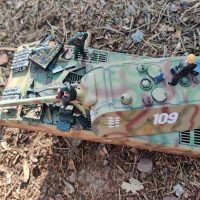

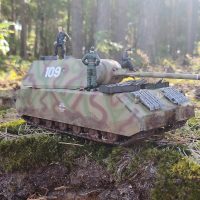


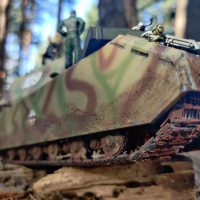







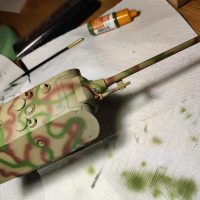


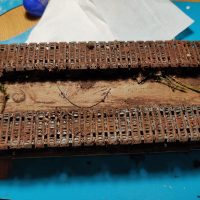


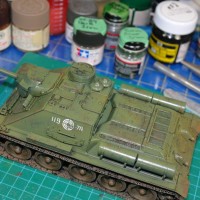


What a beast! looks great, as do your figures.
Thank You. I am very proud of the result. I am not expert in figure painting, but I had tried hard. Especially in the case of eyes. It is very easy to simplify it a destroyed whole the mimic.
🙂 ... Greetings ... 🙂 :
Off to armor building with a nice start Łukasz , very good change of building from the norm.
I am still devoted to aircraft but it was indeed nice change though.
Looks great and very imposing, Lukasz!
Nice weathering on those tracks!
Thank You. As described I am very proud of this one:)
Nice job, doesn't fit any mouse-trap I have at home in this scale 😀
Very well done, Lukasz! I especially like Willy, the turret mechanic who is standing on top of the turret. He has his P08 "Luger" ready, which in view of where he's standing is pretty incredible! But he's ready for whatever bad may happen!
This is a VERY good start in tank building. I spent 14.5 years on 7 different tanks (M48A5, M60A1, M60A3, M1, M1IP, M1A1, and I went to war - Desert Storm - on/in an M1A1 "Heavy Armour") and you have captured a "moment in time" very well, Sir!
Bravo!
Thank you Jeff (@mikegolf). You had very well described the mood there:)
Looks great! Try a slight brownish wash on the faces and hands and maybe a darker fleshtone on the lips and your figures will look even better.